Whenever my parents come to visit from Hong Kong, I can guarantee that at least half of their suitcases will be filled with little treats and gifts for us. They’re great parents that way. When they arrived last weekend I knew that among the clothes, candies, and baked goods (yes, my mother has been known to bring boxes of custard tarts and coconut buns from my favorite HK bakeries; now if only there were a way to get dim sum across the Pacific while it’s hot) there would be several beautifully decorated boxes of mooncakes to celebrate the Mid-Autumn Festival.
At its most elegant and poetic, the Mid-Autumn Festival celebrates the time of year when the moon is at its fullest and brightest – the harvest moon, or the autumnal equinox. Traditionally, families will gather together to admire the beauty of the full moon, eating mooncakes under the night sky, with children running about carrying colorful paper lanterns like errant fireflies.
There is another, bloodier aspect to the Mid-Autumn Festival and mooncakes which traces back to the 14th century when China was under the rule of the Mongols. Planning a rebellion against the Mongol emperor, Chinese rebels came up with the idea of hiding a secret message inside mooncakes, which the Mongols did not eat. These mooncakes told rebels to rise up on the night of the Mid-Autumn Festival. The uprising was successful, and henceforth the Mid-Autumn Festival was celebrated with mooncakes everywhere in China.
Given the mooncake’s firm entrenchment in Chinese culture, it would be impossible to get through a Mid-Autumn Festival without giving or receiving dozens of these little puck-shaped pastries. Just like red envelopes are passed out to children and subordinates at Chinese New Year, so friends and family engage in a little hot-potato pass-around of mooncakes. If you are also detecting a resemblance to that dreaded Christmas fruitcake, you are not wrong. The traditional Chinese mooncake is an acquired taste for many; for me, suffice to say that it does not fall to the level of fruitcake but neither is it among my most favorite desserts. I blame my mother for this failure of my tastebuds; I was told that as a child her father offered her five dollars (quite a significant amount at the time) to eat a mooncake, and she refused.
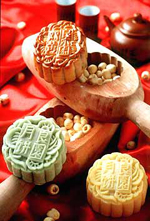
The traditional mooncake is quite dense for its size, with a soft, chewy, golden crust made of flour, sugar syrup, and lard enveloping a rich filling of lotus bean paste and a whole salted duck egg yolk to symbolize the full moon. The mooncake is formed in a wooden mold imprinted with the bakery’s insignia on top; since each bakery will have a different design for its mooncakes, those from the most reputable bakeries are highly coveted – orders for mooncakes are placed months in advance!
Because of its richness, the mooncake is typically meant to be cut into quarters and shared; if you can’t get enough of that egg yolk, many bakeries have a "super" mooncake with four egg yolks, one in each quarter. These are considered to be some of most luxurious and expensive of all mooncakes.
So the traditional mooncake is not quite to your liking? Bakeries must have realized there was a market for an improved, less calorie- and cholesterol-filled moon cake, and today the variety of mooncakes boggles the eye and wallet – some of them can hardly be called mooncakes save some tenuous similarity in form.
Substituting the expensive lotus bean paste with cheaper and sweeter fillings was a natural; you can find mooncakes with sweeter red bean pastes, fruit fillings, even ice cream. One of the most charming versions I’ve seen this year is Pappagallo’s Gelato Mooncakes, embossed with a design based on Saint-Exupery’s Le Petit Prince. Not that I recall the little prince eating mooncakes on his asteroid…
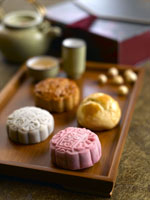
A most popular variant of the mooncake is the unbaked, or snow-skin version, using a rice-flour, mochi-style wrapper around the filling. While these mooncake require refrigeration and are much less long-lasting than their baked cousins, their much more delicate texture and adaptability to a wide range of fillings have made them a great favorite among modernists. I will admit I love the rainbow of pastel colors they come in, as well the staggering heights of creativity to which the fillings have reached in recent years – everything from truffles to green tea custard to durian to birds’ nest.
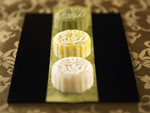
And final proof that mooncakes are adapting to the modern age: Häagen-Dazs and Starbucks have their own versions of mooncakes for Mid-Autumn Festival. The Häagen-Dazs sounds clever if not particularly moon-cakeish: The egg yolk has been replaced with a ball of mango sorbet, the filling with ice cream, and the crust with a chocolate shell, but the Starbucks coffee mooncake is one I think I’ll pass on.
I’m pleased to see that this ancient delicacy that could have been easily mothballed has instead benefited from the innovation of pastry chefs, evolving to suit ever-changing times and tastes.But however much I think I would enjoy a mooncake-shaped ice cream, I still smile when my mom uncovers those traditional glossy brown mooncakes that she brought all the way from Hong Kong. To me, they represent the real meaning of Mid-Autumn Festival and the exchanging of those little pastries: to celebrate family and being together, under the warm light of a glowing moon.
The Mid-Autumn Festival is always on the 15th day of the 8th lunar month. This year it falls on October 6th.
Tagged with: mooncake + Mid Autumn Festival
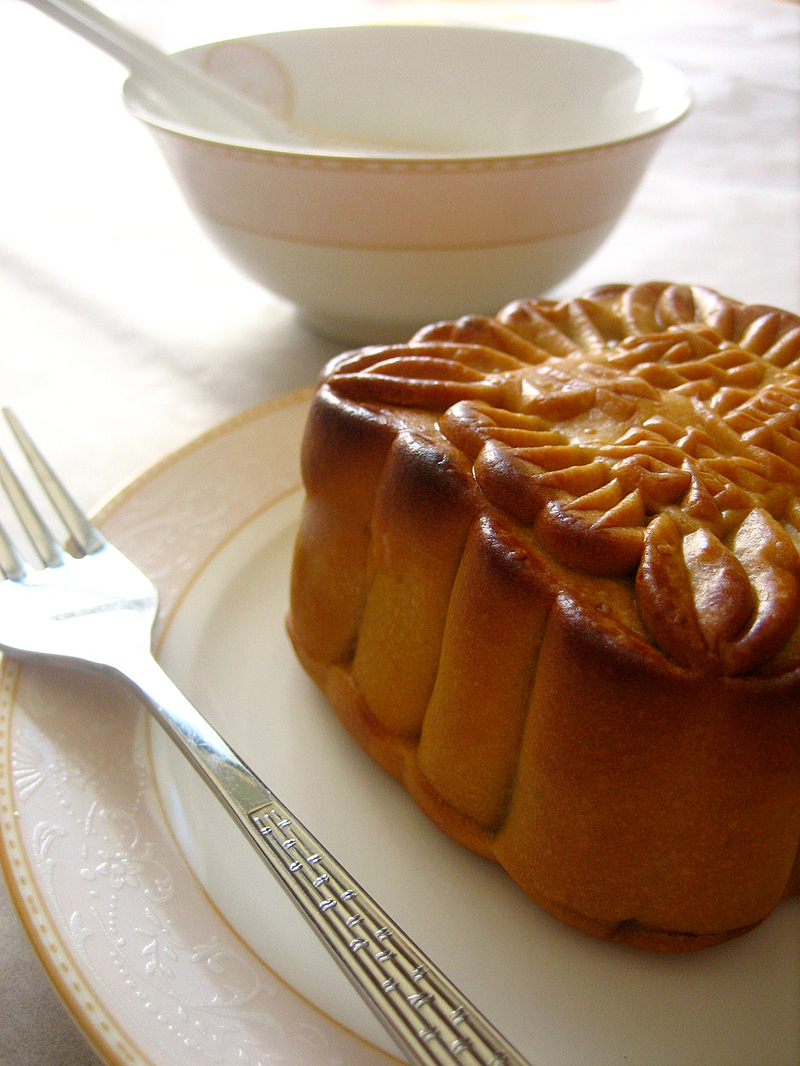
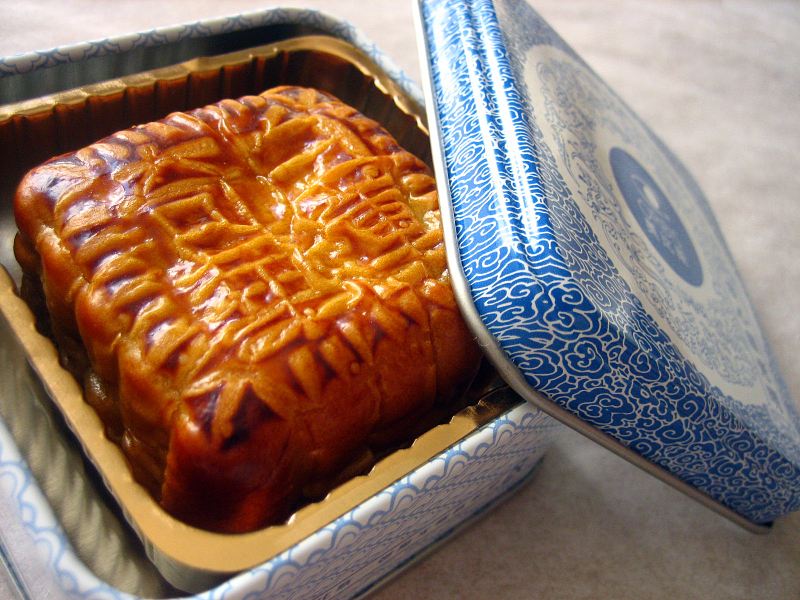
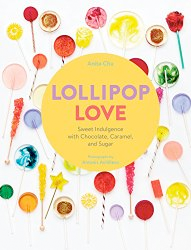

My mom loves mooncakes although I don’t care for them. My brother often brings dim sum home with him by freezing it. This usually works for him during the winter months as the cargo hold often keeps the dim sum frozen until he reaches his destination 🙂 Enjoy the time with your family!
Well…they certainly look tasty and its hard to beat the name! Thanks for the enlightening info on these babies!
Thanks for all the wonderful information surrounding mooncakes! I like the red bean or lotus seed paste ones – minus the egg yolk.
Hi Anita,
I am a HUGE fan of your blog! Your desserts always look so beautiful. I am still somewhat new to blogging, and have been “lurking” for quite some time. I just had to comment on this post…it brought back so many memories of being together with my grandparents in HK, eating mooncakes. I was actually in HK last summer and noticed that they had frozen mooncakes at Maxim’s bakeries. Interesting new innovation!
Wow, thanks for that. What a great history lesson for something I knew little about. I am quite sure that in Seattle I can find some mooncakes so now I will have to go look for some.
so little and so many elegants!
kiss
Thanks for teaching me about Mooncakes! That’s really interesting. Glad I visited your blog this morning.
d.
Mooncakes are so pretty, the new adaptations sound quite interesting.
Wonderful!!! I was just given a gift of small round pineapple filled mooncakes and some small square red bean paste filled mooncakes.
These little cakes are so teeny, definetly bite-sized. I;ll have to take some shots to share with you 🙂
Thank you for such a clear and detailed story about the history of the mooncake. Everytime I have asked my chinese friends I either get “Oh numnumnumnum I love mooncakes!” or a wrinkled nose and a sour face, but never an explanation of their origin and significance.
I think I will be enjoying my little cakes on the 6th 🙂
hi Anita,
Ah, those mooncakes look absolutely beautiful and how nice to celebrate this with your family(!)
the mid autumn festival sounds lovely – enjoyed reading about it =)
mooncakes…definitely an acquired taste. i gotta try the ice cream version.
Kat,
Thanks for the dim sum tip, I might convince my parents to try that next time:)
Catherine,
Perhaps you might be able to try some of the vegan versions that don’t have eggs in them – I think they’re tastier anyways!
Sam,
The red bean ones are my favorite – some of the new ones are too “out there” for me!
T,
Thanks so much for your kind comments! My mom is always telling me about all the new mooncakes they come up with, they’re getting so creative!
Peabody,
Is there a Chinatown in Seattle? I’m sure they would have some great mooncakes:)
Daniela,
Thank you! I love checking out the different patterns on the tops of mooncakes!
Deb,
Thanks for visiting and I’m glad you liked the post!
Brilynn,
I agree, the new ones they’re coming up with are mind-boggling! Thanks for your comment!
Kelly,
Thanks for stopping by! I hope you enjoyed your mooncakes under the full moon:)
Julia,
Thank you! It’s always nice to get mooncakes from family (even if I don’t eat all of them:) – it’s the sharing that counts!)
Daily Quote,
The ice cream version is probably the easiest to get into!
I was recently in Singapore for the mooncake festival. I love any and all mooncakes but what made me weak was this just baked mooncake ensconced in a flaky pastry. It melted in my mouth upon first bite surrendering to the sweet, pasty filling. Unforgettable!
Thanks for your blog about mooncake and mid-autumn festival. I just celebrated the Mid-Autumn Festival in China, so want to add some comments:
(1) Even for the traditional lotus seed and red bean paste mooncakes, the quality can vary a lot depending on the pastry shops. They may not be that filling and rich. We had excellent ones in Shanghai. Here is an analogy. 99% of the Peking ducks on market are very rich and filling, but the real good ones have a completely different feel – they melt in your mouth and you just want more. The constraint is that you can get these real ones only at a couple of authentic places in China.
(2) Osmanthus is the flower for mid-autumn festival! Legend has it that the Mongol king was enticed to invade China after he read a poem describing the country wrapped in the scent of osmanthus. The scent is just amazing. Recently Hermes released their exclusive perfume of Osmanthe Yunnan. When I was touring China this October, Osmanthus was blooming everywhere in the city of Hangzhou. You just have to stop and take a deep breath to get more of the scent. I completely understand why the Mongol king wanted to go south.
(3) Osmanthus flowers may be used in mooncakes just as they are used in tea and other deserts.
Lori,
Lucky you! I’ve heard Singapore makes some fabulous mooncakes!
Sophia,
Thank you for the interesting tidbits! I want to find that perfume now!